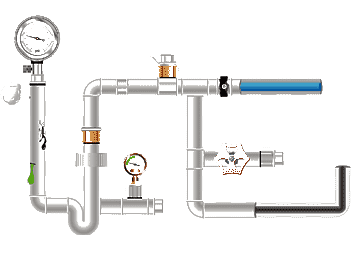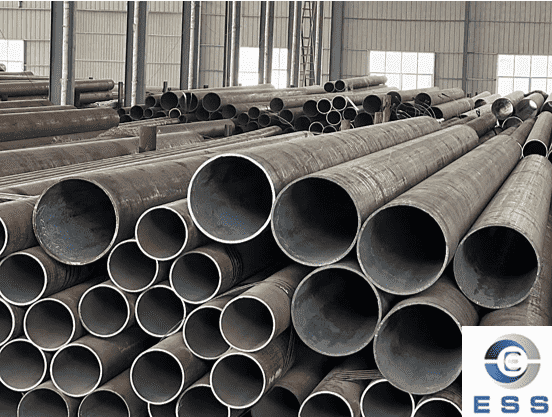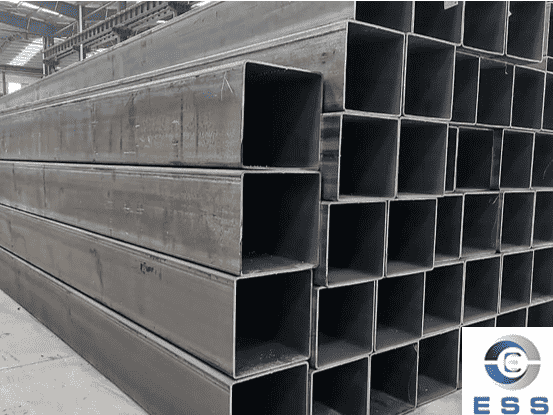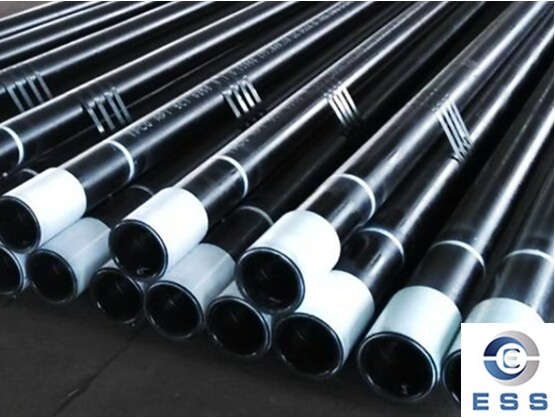Carbon steel pipe is the most common type
of steel pipe. It is made from ingots or solid round steel, perforated into a
rough tube, and then hot-rolled, cold-rolled, or cold-drawn. It can be
categorized as seamless carbon steel pipe,
straight-seam, and spiral carbon steel pipe.
Carbon steel is a type of steel with a high
carbon content, an alloy of iron and carbon. It is divided into three
categories: high-carbon steel, medium-carbon steel, and low-carbon steel. The
mass fraction of carbon ranges from 0.05% to 2.5%. Carbon steel pipe is known
for its hardness and durability.
Black steel pipe is uncoated steel pipe.
Its dark color comes from iron oxide formed on its surface during the
manufacturing process. During forging, a black oxide layer forms on the
surface, giving this type of pipe its smooth finish.
Black steel pipe is commonly made from
low-carbon steel plate or billet. The main processes used to manufacture it are
seamless black steel pipe and welded black steel pipe. Seamless black steel
pipe is made directly from hot-rolled or cold-drawn seamless
pipe. Welded black steel pipe is made by welding steel sheets from
rolled sheets and then heat-treating them.
Black steel pipe is inexpensive and
versatile. It can transport a variety of media, such as oil, natural gas,
waste, and sludge.
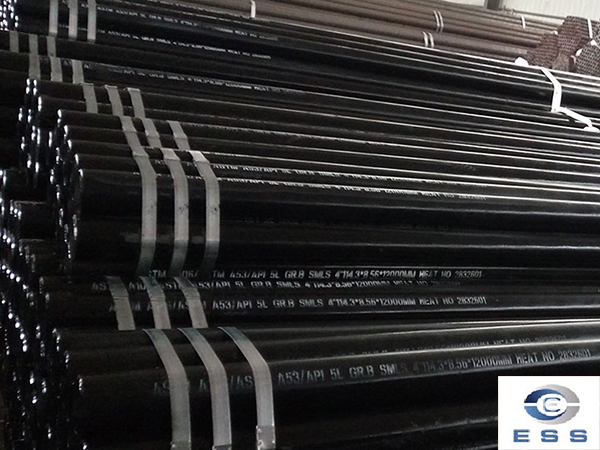
The Difference Between Carbon Steel and
Black Steel
|
Difference
|
Carbon Steel
|
Black Steel
|
|
Definition
|
Carbon steel is a form of steel
containing carbon as a major constituent.
|
Black steel is non-galvanized and has
dark-coloured iron oxide coating on the surface.
|
|
Surface Finish
|
Carbon steel, in their raw state, have a
silvery-grey appearance. They may or may not have a protective coating,
depending on their intended use and the manufacturer’s specifications.
|
Black steel have a dark, matte black
finish due to the blackening process they undergo. This blackening is
achieved by applying a black oxide layer to the surface of regular steel.
|
|
Carbon Content
|
Has carbon content up to 2.1% by weight.
|
Carbon content 0.3%~1.7%.
|
|
Hardness
|
The hardness of carbon steel depends on
the carbon content.
|
The black steel has high strength and
hardness.
|
|
Galvanization
|
Requires galvanization because this steel
is susceptible to corrosion.
|
Is a non-galvanized steel.
|
Composition Differences
Carbon steel pipe is primarily composed of
iron and carbon (typically 0.05% to 2.0%), with trace elements such as
phosphorus, sulfur, silicon, and manganese.
Compositionally, black steel pipe is not
significantly different from carbon steel pipe. In fact, black steel pipe is
carbon steel pipe that has undergone a special treatment process. Its primary
components are iron and carbon, but it is not galvanized or coated, but instead
has an iron oxide layer.
Manufacturing Differences
Carbon steel pipe can be categorized as
seamless (produced by hot rolling or cold drawing) or welded (straight seam
welded or spiral welded).
Black steel pipe is manufactured using a
similar process to carbon steel pipe and can be categorized as seamless or
welded, but it always remains uncoated.
Differences in Temperature and Pressure
Resistance
Black steel pipe comes in a variety of
grades, with performance tailored to specific temperature and pressure ratings.
Key factors to consider are generally the steel grade, gauge, and thickness.
Carbon steel pipe can withstand temperatures up to 650°C
and is often used for high-pressure fluid transport (e.g., ASTM A106
high-temperature pipe).
Like carbon steel pipe, black steel pipe
also offers excellent resistance to high temperatures and pressures, as its
composition enables it to withstand high temperatures. However, black steel
pipe is more commonly used in medium- and low-pressure fluids and structural
applications.
Corrosion Resistance Differences
Carbon steel pipe is susceptible to rust if
not galvanized or otherwise treated for corrosion, as carbon steel does not
contain chromium. However, corrosion resistance can be improved through
galvanizing, lining, or coating.
Black steel pipe lacks a galvanized coating
on the exterior, making it susceptible to corrosion damage. For optimal
performance, it should be used indoors. While black steel pipe is a popular
choice for oil and gas transportation, it is not recommended for domestic water
supply.
Appearance Differences
Carbon steel pipe has a rough, matte, and
dull metallic surface. Oxidation can lead to a rusty finish.
Black steel pipe has a dark, rough surface
to the touch, due to a layer of iron oxide.
Cost Differences
Because of the wide variety of carbon steel
pipe grades, prices vary widely. Mild
steel pipe is inexpensive, while high-carbon
steel pipe is more expensive. For example, ASTM A36 mild steel pipe is
significantly less expensive than ASTM AISI 1059 pipe.
Black steel pipe is simple to manufacture
and affordable. It's well-suited for a variety of transportation and structural
applications, being economical, weldable, and versatile.
Application Differences
Carbon steel pipe is most commonly used in
structural applications such as buildings and bridges.
Black steel pipe is seamless, making it
commonly used to transport fluids such as water, natural gas, and oil.
Environmental Differences
Steel is inherently a relatively
environmentally friendly material. This makes black steel more environmentally
friendly and sustainable, as the blackening process simply adds a hardening
layer of iron oxide to the surface, while carbon steel must be carburized,
which releases more carbon dioxide into the atmosphere than the blackening
process.
If environmental considerations are a
concern, black steel pipe is the best choice. If you need stronger steel to
withstand significant structural loads or similar load-bearing tasks, carbon
steel pipe is almost always the best choice.
Conclusion
Carbon steel pipe is versatile, while black
steel pipe offers a combination of strength and cost-effectiveness. Carbon
steel pipe and black steel pipe are the industry's mainstays. Choosing between
them depends on your needs. For example, if you're designing an indoor plumbing
system, you'd likely prefer corrosion-resistant mild steel pipe. In structural
applications, black steel pipe can be used as beams and scaffolding, providing
a sturdy solution.









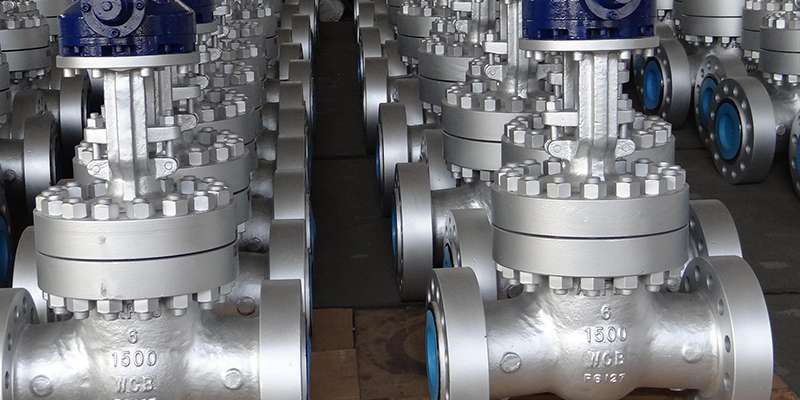



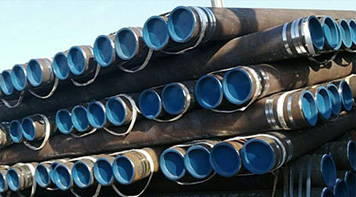 Eastern Steel Manufacturing Co.,Ltd not only improve product production and sales services, but also provide additional value-added services. As long as you need, we can complete your specific needs together.
Eastern Steel Manufacturing Co.,Ltd not only improve product production and sales services, but also provide additional value-added services. As long as you need, we can complete your specific needs together.
